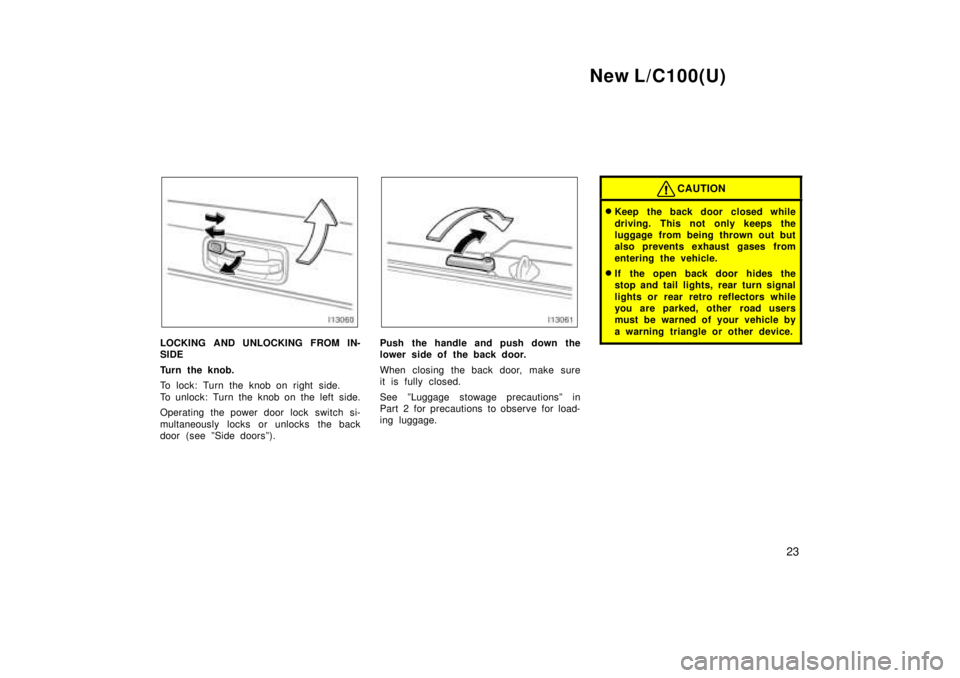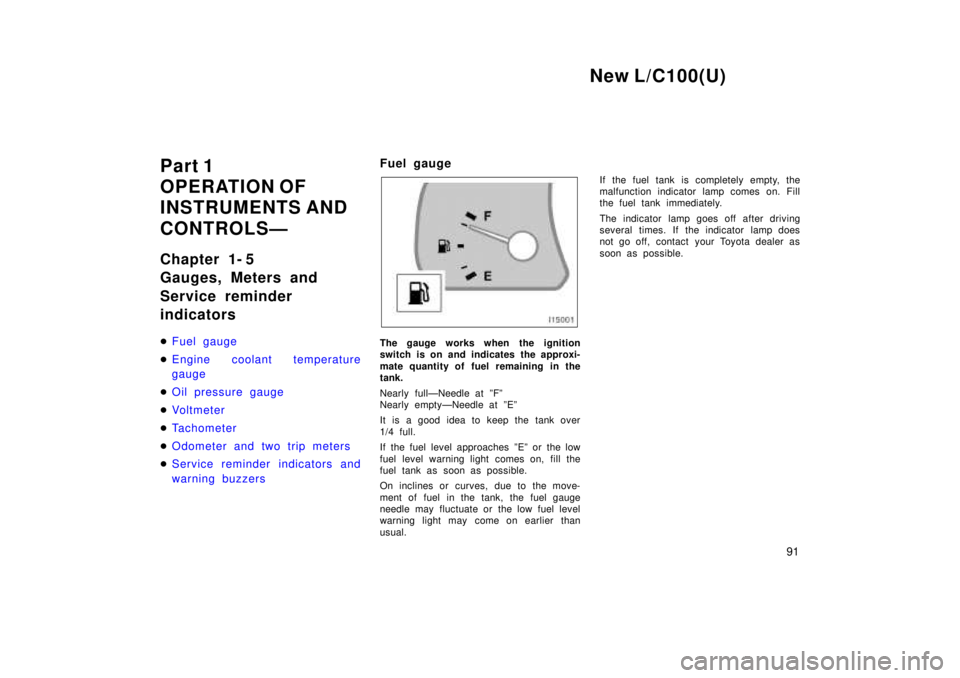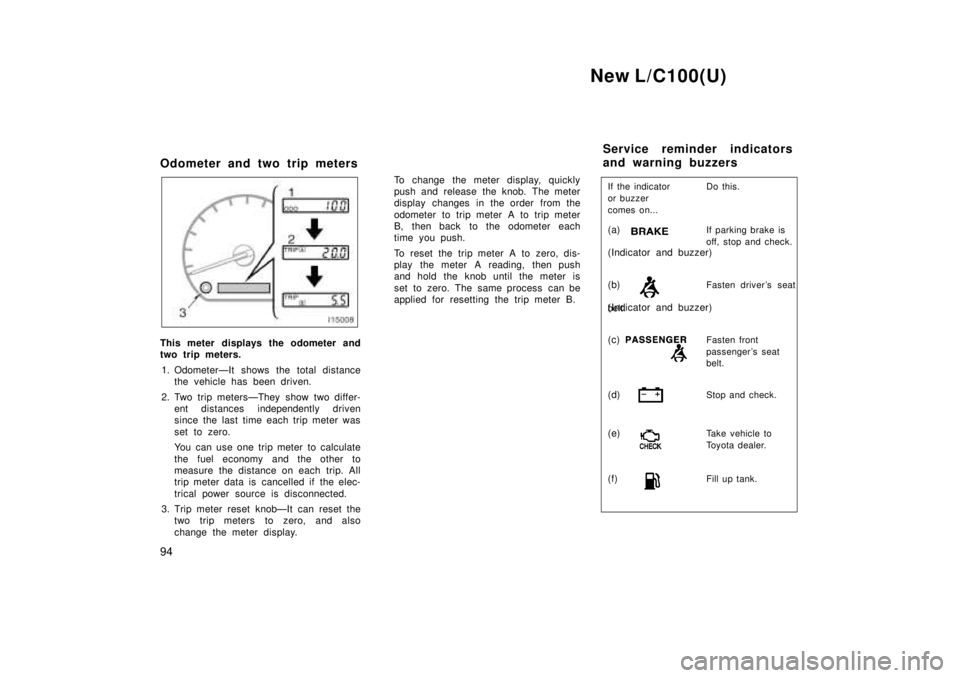1999 TOYOTA LAND CRUISER warning
[x] Cancel search: warningPage 15 of 202

New L/C100(U)23
LOCKING AND UNLOCKING FROM IN-
SIDE
Turn the knob.
To lock: Turn the knob on right side.
To unlock: Turn the knob on the left side.
Operating the power door lock switch si-
multaneously locks or unlocks the back
door (see ºSide doorsº).Push the handle and push down the
lower side of the back door.
When closing the back door, make sure
it is fully closed.
See ºLuggage stowage precautionsº in
Part 2 for precautions to observe for load-
ing luggage.
CAUTION
�Keep the back door closed while
driving. This not only keeps the
luggage from being thrown out but
also prevents exhaust gases from
entering the vehicle.
� If the open back door hides the
stop and tail lights, rear turn signal
lights or rear retro reflectors while
you are parked, other road users
must be warned of your vehicle by
a warning triangle or other device.
Page 43 of 202

New L/C100(U)51
This indicator comes on when the igni-
tion key is turned to the ºACCº or
ºONº position. It goes off after about
6 seconds. This means the front seat
belt pretensioners are operating proper-
ly.
This warning light system monitors the
airbag sensor assembly, front airbag sen-
sors, seat belt pretensioner assemblies,
warning light, interconnecting wiring and
power sources. (For details, see ºService
reminder indicators and warning buzzersº
in Chapter 1- 5.)The seat belt pretensioner system mainly
consists of the following components and
their locations are shown in the illustra-
tion.1. Front airbag sensors
2. SRS warning light
3. Seat belt pretensioner assemblies
4. Airbag sensor assembly
The seat belt pretensioner is controlled by
the airbag sensor assembly. The airbag
sensor assembly consists of a safing sen-
sor and airbag sensor. When a seat belt pretensioner is acti-
vated, an operating noise may be heard
and a small amount of smoke- like gas
may be released. This gas is harmless
and does not indicate that a fire is occur-
ring.
Once the seat belt pretensioner has been
activated, the seat belt retractor remains
locked.
CAUTION
Do not modify, remove, strike or open
the front seat belt pretensioner as-
semblies, airbag sensor or surround-
ing area or wiring. Doing any of
these may cause sudden operation of
the front seat belt pretensioners or
disable the system, which could re-
sult in serious injury.
Failure to follow these instructions
can result in serious injuries.
Page 45 of 202

New L/C100(U)53
The SRS (Supplemental Restraint Sys-
tem) airbags are designed to provide
further protection for the driver and
front passenger when added to the pri-
mary protection provided by the seat
belts.
In response to a severe frontal impact,
the SRS airbags work together with the
seat belts to help prevent or reduce injury
by inflating, in order to decrease the likeli-
hood of the driver 's or front passenger 's
head or chest directly hitting the steering
wheel or dashboard. The passenger airbag
is activated even with no passenger in the
front seat.
Be sure to wear your seat belt.
CAUTION
A driver or front passenger too close
to the steering wheel or dashboard
during airbag deployment can be
killed or seriously injured. Toyota
strongly recommends that: �The driver sit as far back as pos-
sible from the steering wheel while
still maintaining control of the ve-
hicle.
� The front passenger sit as far back
as possible from the dashboard.
� All vehicle occupants be properly
restrained using the available seat
belts.
This indicator comes on when the igni-
tion key is turned to the ºACCº or
ºONº position. It goes off after about
6 seconds. This means the SRS airbags
are operating properly.
This warning light system monitors the
airbag sensor assembly, front airbag sen-
sors, inflators, warning light, interconnect-
ing wiring and power sources. (For details,
see ºService remainder indicators and
warning buzzersº in Chapter 1- 5.)
SRS driver and front
passenger airbags
Page 47 of 202

New L/C100(U)55
Hitting a curb,
edge of pavement
or hard materialFalling into or
jumping over a
deep hole
Landing hard or vehicle falling
The SRS airbags may deploy if a seri-
ous impact occurs to the underside of
your vehicle. Some examples are shown
in the illustration.
The SRS airbag system mainly consists of
the following components and their loca-
tions are shown in the illustration. 1. Front airbag sensors
2. SRS warning light
3. Airbag module for passenger (airbag and inflator)
4. Airbag sensor assembly
5. Airbag module for driver (airbag and inflator)
The airbag sensor assembly consists of a
safing sensor and airbag sensor. In a severe frontal impact, sensors detect
deceleration and the system triggers the
airbag inflators. Then a chemical reaction
in the inflators momentarily fills the air-
bags with non- toxic gas to help restrain
the forward motion of the occupants.
When the airbags inflate, they produce a
fairly loud noise and release some smoke
and residue along with non- toxic gas. This
does not indicate a fire. This gas is nor-
mally harmless, however, for those who
have delicate skin, it may cause minor
skin irritation. Be sure to wash off any
residue as soon as possible to prevent
minor skin irritation.
Deployment of the airbags happens in a
fraction of a second, so the airbags must
inflate with considerable force. While the
system is desi
gned to reduce serious inju-
ries, it may also cause minor burns or
abrasions and swellings.
Parts of the airbag module (steering wheel
hub, dashboard) may be hot for several
minutes, but the airbags themselves will
not be hot. The airbags are designed to
inflate only once.
Page 83 of 202

New L/C100(U)91
Part 1
OPERATION OF
INSTRUMENTS AND
CONTROLSÐ
Chapter 1- 5
Gauges, Meters and
Service reminder indicators �
Fuel gauge
�Engine coolant temperature gauge
�Oil pressure gauge
�Volt m et er
�Tachometer
�Odometer and two trip meters
�Service reminder indicators and
warning buzzers
Fuel gauge
The gauge works when the ignition
switch is on and indicates the approxi-
mate quantity of fuel remaining in the
tank.
Nearly fullÐNeedle at ºFº
Nearly emptyÐNeedle at ºEº
It is a good idea to keep the tank over
1/4 full.
If the fuel level approaches ºEº or the low
fuel level warning light comes on, fill the
fuel tank as soon as possible.
On inclines or curves, due to the move-
ment of fuel in the tank, the fuel gauge
needle may fluctuate or the low fuel level
warning light may come on earlier than
usual.
If the fuel tank is completely empty, the
malfunction indicator lamp comes on. Fill
the fuel tank immediately.
The indicator lamp goes off after driving
several times. If the indicator lamp does
not go off, contact your Toyota dealer as
soon as possible.
Page 86 of 202

New L/C100(U)
94
Odometer and two trip meters
This meter displays the odometer and
two trip meters.
1. OdometerÐIt shows the total distance the vehicle has been driven.
2. Two trip metersÐThey show two differ- ent distances independently driven
since the last time each trip meter was
set to zero.
You can use one trip meter to calculate
the fuel economy and the other to
measure the distance on each trip. All
trip meter data is cancelled if the elec-
trical power source is disconnected.
3. Trip meter reset knobÐIt can reset the two trip meters to zero, and also
change the meter display. To change the meter display, quickly
push and release the knob. The meter
display changes in the order from the
odometer to trip meter A to trip meter
B, then back to the odometer each
time you push.
To reset the trip meter A to zero, dis-
play the meter A reading, then push
and hold the knob until the meter is
set to zero. The same process can be
applied for resetting the trip meter B.
(c)Fasten front
passenger's seat
belt.
If the indicator Do this.
or buzzer
comes on...
(a)
If parking brake is
off, stop and check.
(b) Fasten driver's seat
belt .
(d) Stop and check.
(f) Fill up tank.
(e)
Take vehicle to
Toyota dealer.
(Indicator and buzzer)
(Indicator and buzzer)
Service reminder indicators
and warning buzzers
Page 87 of 202

New L/C100(U)95
(g)Take vehicle to
To y o t a
d ealer
immediately.
(i) Close all side doors
and back door.
(k) Stop and check.
(j)Shift four-wheel
drive control out
of ºNº.
Key reminder
buzzer
(h) Take vehicle to
Toyota dealer.
If the indicator Do this.
or buzzer
comes on...
(l) Remove key.(a) Brake System Warning Light and
Buzzer
This light has the following functions:
Parking brake reminder
If this light is on, make sure the parking
brake is fully released. The light should
go off.
Low brake fluid level warning
If this light comes on and stays on while
you are driving, slow down and pull off
the road. Then stop the vehicle carefully.
Remember that stopping distance and ped-
al effort may be increased. There may be
a problem somewhere in the brake sys-
tem. Check the fluid level of the see-
through reservoir.
To make sure the parking brake has not
caused the warning light to come on,
check to see that the parking brake is
fully released.
If the brake fluid level is low...
At a safe place, test your brakes by start-
ing and stopping.
� If you judge that the brakes still work
adequately, drive cautiously to your
nearest dealer or shop for repairs. �
If the brakes are not working, have the
vehicle towed in for repairs. (For tow-
ing information, see Part 4.)
CAUTION
It is dangerous to continue driving
normally when the brake fluid level is
low.
If the brake fluid level is correct...
Have the warning system checked by your
Toyota dealer.
Brake system failure warning
The light may stay on for about 60 sec-
onds after the engine is started. It is nor-
mal if it goes out after a while.
If the brake system warning light stays on
even with the parking brake being re-
leased, the brake system may fail. Con-
tact your Toyota dealer.
If the hydraulic boost pressure is lowered,
the warning light comes on and buzzer
sounds continuously. Immediately stop
your vehicle at a safe place and contact
your Toyota dealer. In this case, the
brakes may not work properly. if they do
not work well, depress the brake pedal
firmly.
Page 88 of 202

New L/C100(U)
96
Depressing the brake pedal repeatedly
may turn on the warning light and buzzer.
It is normal if the light goes out and the
buzzer stops sounding after a few sec-
onds.
CAUTION
Continued driving with an inoperative
brake booster is dangerous.
(b) Driver's Seat Belt Reminder Light
and Buzzer
Once the ignition key is turned to ºONº or
ºSTARTº, the reminder light flashes and
the buzzer sounds if the driver 's seat belt
is not fastened. Unless the driver fastens
the belt, the light keeps on flashing and
the buzzer sounds 4 to 8 seconds.
(c) Front Passenger 's Seat Belt Re- minder Light
Once the ignition key is turned to ºONº or
ºSTARTº, the reminder light flashes if a
passenger sits in the front passenger seat
and does not fasten the seat belt. Unless
the front passenger fastens the belt, the
light stays flashing. If luggage load is placed on the front
passenger seat, depending on its weight
and how it is placed on the seat, built- in
sensors in the seat cushion may detect
the pressure, causing the reminder light to
come on.
(d) Discharge Warning Light
This light warns that the battery is being
discharged.
If it comes on while you are driving, there
is a problem somewhere in the charging
system.
The engine ignition will continue to oper-
ate, however, until the battery is dis-
charged. Turn off the air conditioning,
blower, radio, etc., and drive directly to
the nearest Toyota dealer or repair shop.
NOTICE
Do not continue driving if the engine
drive belt is broken or loose.
(e) Malfunction Indicator Lamp
This lamp comes on in the following
cases.
a. The fuel tank is completely empty. (See
ºFuel gaugeº in Chapter 1- 5 for instruc-
tions.)
b. The fuel tank cap is not tightened se-
curely. (See ºFuel tank capº in Chapter
1- 2 for instructions.)
c. There is a problem somewhere in your
engine electrical system, automatic trans-
mission electrical system or electronic
throttle control system.
If it comes on while you are driving in
case c, have your vehicle checked/re-
paired by your Toyota dealer as soon as
possible.
(f) Low Fuel Level Warning Light
This light comes on when the fuel level
in the tank becomes nearly empty. Fill up
the tank as soon as possible.